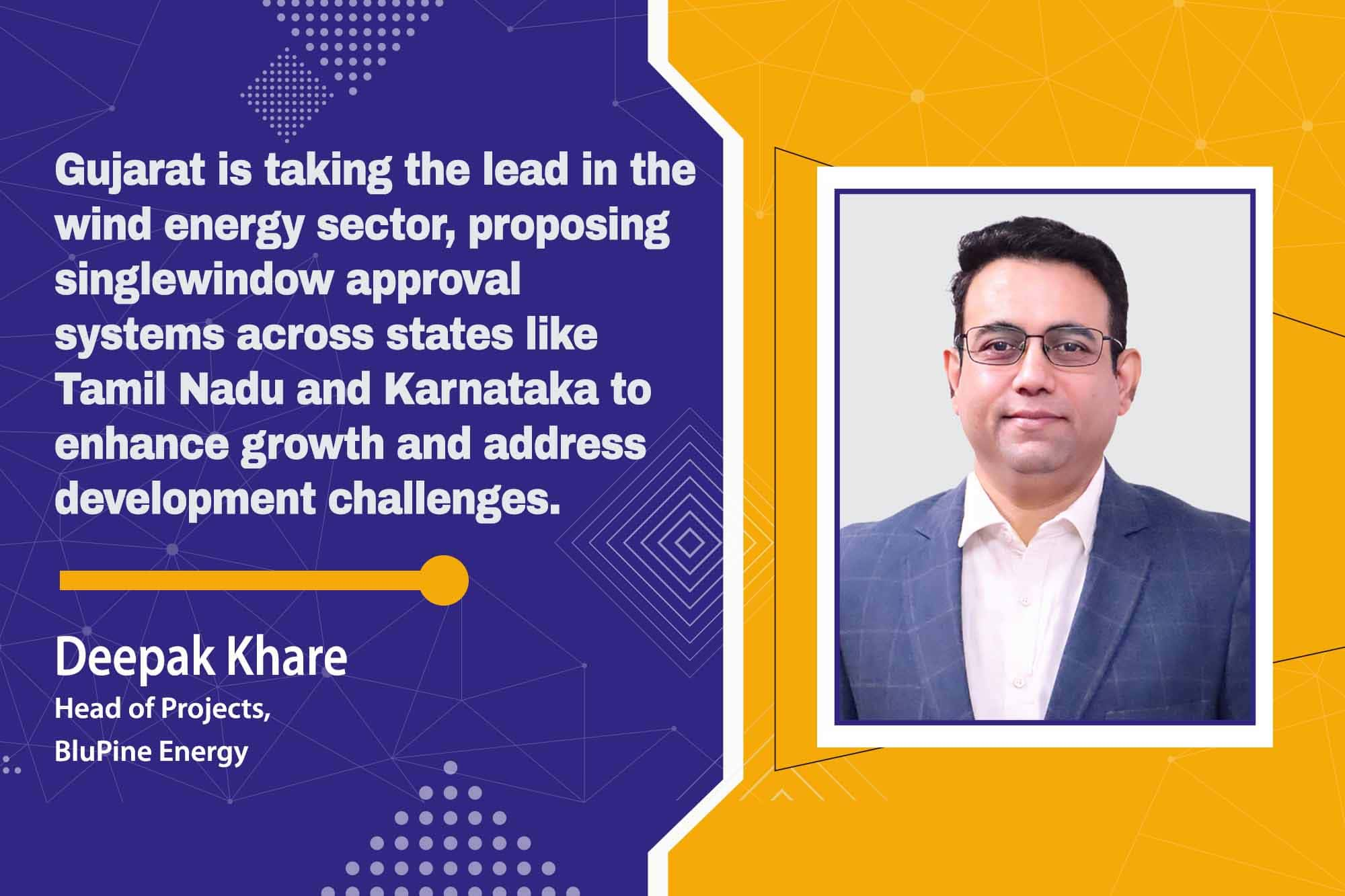India to triple wind power capacity by 2030
By EPR Magazine Editorial May 25, 2024 7:03 pm IST
By EPR Magazine Editorial May 25, 2024 7:03 pm IST

Gujarat is taking the lead in the wind energy sector, proposing single-window approval systems across states like Tamil Nadu and Karnataka to enhance growth and address development challenges.
What recent market dynamics are fueling the growth of wind power?
What challenges do they pose for industry stakeholders? India’s wind energy sector is on the cusp of significant expansion, driven by recent market dynamics and government initiatives. With an existing 45 GW of installed wind capacity, constituting around 25 percent of non-fossil renewable energy capacity, India aims to triple its wind capacity by 2030. However, achieving this ambitious target requires a more rapid deployment of wind power, presenting both opportunities and challenges for industry stakeholders. Opportunities Vast Wind Resource Potential: The National Institute of Wind Energy (NIWE) estimates a staggering potential of 700 GW at 120-meter height, with less than 10 percent currently tapped. This abundance of wind resources provides a fertile ground for substantial growth in wind power generation.
Domestic Manufacturing:
Wind capacity in India presents a significant opportunity for domestic consumption, with two-thirds available for 15 GW of wind turbine assembly.
Technological Advancements:
Advanced technologies, such as turbines with 160m hub height and carbon fibre blades, are revolutionizing wind power, resulting in reduced costs and improved efficiency.
Exploring Offshore Potential:
Gujarat and Tamil Nadu, with over 70 GW of offshore wind capacity, present a lucrative opportunity for development, supported by government initiatives like Viability Gap Funding (VGF) until tariffs become feasible.
Challenges Site Selection:
The Airport Authority is requiring No Objection Certificates (NOCs) for over 100 airports under the Udan Scheme, while the MOD’s clearance and connectivity approval add complexity to the site selection process.
Complexities in Land Acquisition:
Wind Turbine Generators (WTG) require substantial land, often involving multiple landowners. Negotiations with these landowners can be complex, leading to delays and increased costs. Right-of-Way (ROW) issues, involving multiple villages and stakeholders, also complicate land acquisition, causing significant delays in project completion.
Limited WTG OEMs and Supply Chain: The limited number of Original Equipment Manufacturers (OEMs) catering to domestic demands, coupled with their focus on exports, highlights the need for production-linked incentives to bolster the supply chain and meet the growing demand for wind turbines in India. Inadequate Transmission Infrastructure: Remote locations necessitate longer transmission lines (66 kV/220 kV Extra High Voltage), resulting in higher costs and operational losses.Demand centres are crucial for wind projects, but approval delays can hinder their successful integration. The need for robust transmission infrastructure and efficient permits and approvals from central and state governments can help accelerate project execution and achieve capacity expansion.
Shortage of Skilled Workforce: The wind energy industry faces a significant challenge from the shortage of skilled manpower. Collaborative efforts between industry players, academia, and policymakers are essential to address this skill gap and ensure the availability of a qualified workforce to support the sector’s growth.
How are governments adapting their incentive frameworks to support the expansion of wind power generation amidst changing energy policies?
Gujarat is enhancing incentives to support wind power generation, implementing single-window approval systems, and pre-fixed tariff allocations for small renewable energy developers. The government advocates for integrated ‘Wind-Solar-Battery’ projects, with recent tenders following Fixed Day-Ahead, Real-Time Continuous (FDRE), Power Purchase, and Round-The-Clock (RTC) models. However, wind park development presents challenges like land acquisition, Right-of-Way management, logistics, installation, transmission line construction, and permit acquisition.
How are developers innovating to boost efficiency and cost-effectiveness in wind projects amid growing competition?
In response to intensifying competition and evolving tariff trends, developers are embracing innovative strategies to optimise the efficiency and cost-effectiveness of wind projects. Optimising Power Curves: Wind Turbine Generator (WTG) Original Equipment Manufacturers (OEMs) are optimising power curves based on site-specific conditions to enhance Annual Energy Production (AEP) and reduce the Levelized Cost of Energy (LCOE). This optimisation maximises energy output while minimising operational costs. Transition to Higher-Rating WTGs: The industry is witnessing a shift towards higher-rating WTGs, transitioning from 3x to 4x platform installations. This transition reduces the required WTG footings and significantly lowers overall project costs by over 10 percent.
Pre-Development of Potential Sites: Developers pre-develop potential sites with meteorological masts for wind measurement to reduce uncertainty in AEP estimation. Engaging local communities in the early stages of project development facilitates land acquisition and minimises Right-of-Way issues during project execution.
How does integrating battery storage technology enhance wind power’s reliability and grid integration?
Integrating battery storage with wind power brings significant advantages for grid reliability and managing wind energy variability. By storing surplus energy during high-wind periods and releasing it during low-wind times, battery storage maintains consistent power output, reducing wind power intermittency. Moreover, it aids in frequency regulation by swiftly responding to grid frequency shifts, thereby stabilizing variable renewable sources like wind power. Nonetheless, developers need to tackle various barriers to seamlessly integrate battery storage with wind power.
High Capital Expenditure: Despite decreasing costs, the initial investment in battery storage systems remains a significant hurdle for widespread adoption. Developers need to explore creative financing models to alleviate this financial strain. Additionally, the absence of incentives within the regulatory framework for integrating battery storage with renewables slows down integration efforts. Advocacy for supportive policies incentivizing the deployment of battery storage alongside wind power is crucial for overcoming this barrier.
Technological Challenges: Despite strides forward, challenges persist in battery lifespan, energy density, and efficiency. To ensure the long-term reliability and performance of battery storage systems, developers must invest in R&D to overcome these hurdles. By doing so, they can bolster wind power reliability and grid integration, ushering in a more sustainable energy future.
Spokesperson: Deepak Khare, Head of Projects, BluPine Energy
We use cookies to personalize your experience. By continuing to visit this website you agree to our Terms & Conditions, Privacy Policy and Cookie Policy.